Scientific and production potential of the Institute
Laboratories
Laboratory of Bacteriology
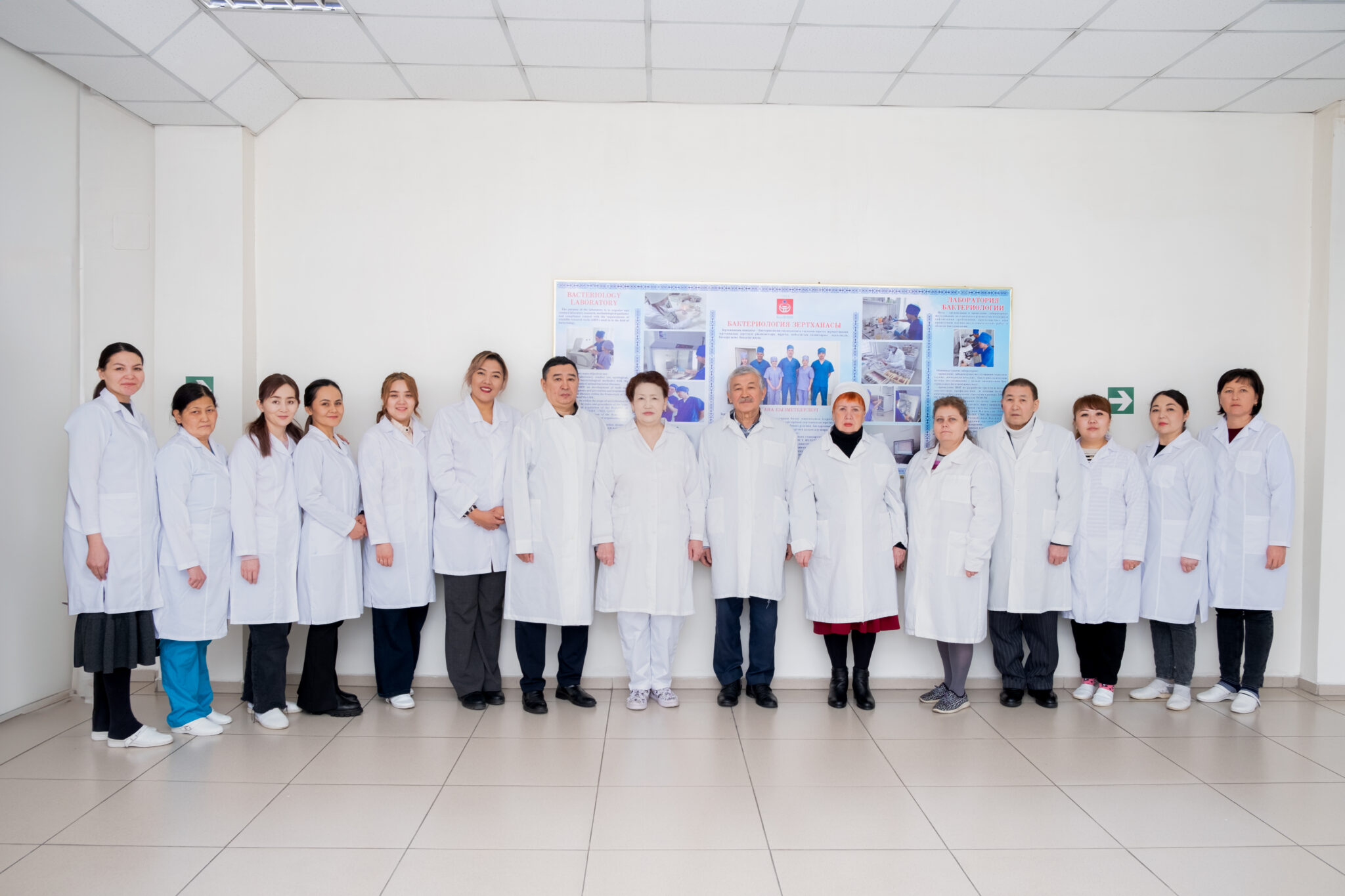
Head of the Bacteriology Laboratory – Candidate of Veterinary Sciences Susсhikh Vlada Yurievna.
Bacteriology Laboratory was founded in 2012 on the basis of laboratories for: diseases of horses and camels (1931), diseases of cattle (1932), diseases of sheep (1956) and tuberculosis (1974).
Over the years, the laboratories were headed by S.J. Tulepbayev, A.R. Sansyzbai, A.B. Bizhanov, B.S. Karataev, V.S. Anisimov, V.M. Petrov, L.A. Afanasyev, Yu.M. Gorelov, K.S. Shmanov, F.E. Sembina, B.F. Kerimzhanova, K.A. Turgenbayev, V.Yu. Susсhikh, A.K. Shaimbetova, U.U. Seitzhanova, B.Zh. Isakulova, F.A. Bakieva, E.K. Ospanov. Since 2025, the virology laboratory is headed by Candidate of Veterinary Sciences Susсhikh Vlada Yurievna
Research direction and objectives:
– study of the epizootological characteristics of the country’s territory for especially dangerous diseases and the development of veterinary and sanitary measures to improve their effectiveness;
– development of tools and methods for the diagnosis, prevention and treatment of animal diseases of bacterial etiology;
– conducting tests according to the declared scope of accreditation in accordance with the rules and procedures of the State System of Technical Regulation of the Republic of Kazakhstan, GOST ISO/IEC 17025, GOST ISO/IEC 17043, Veterinary Legislation of the Republic of Kazakhstan, declared standards of the organization and interstate standards;
– maintenance of production strains of microorganisms used in scientific research.
The main activity of the bacteriology laboratory is the development and improvement of tools and methods for the diagnosis, prevention and treatment of animal diseases of bacterial etiology, analysis of the epizootic situation for bacterial diseases, as well as the establishment of circulation of epizootic strains of particularly dangerous diseases in the territory of the Republic of Kazakhstan.
Main achievements
The staff of the bacteriology laboratory has developed medicines that have been entered into the State Register of Veterinary Medicines of the Republic of Kazakhstan and are being put into practice by state order and through BP 019, which allows veterinarians to effectively control and prevent the spread of bacterial infections among the animal population.
Dry live vaccine against salmonella abortion of mares, No. RK-VP-1-5001-23 .
Live dry vaccine against salmonellosis of calves, no. RK-VP-1-3713-18 .
Vaccine against strangles of horses, no. RK-VP-1-1628-11 .
Live liquid vaccine against anthrax of animals from the strain “55-VNIIVViM”, No. RK-VP-1-3950-19 .
Vaccine against necrobacteriosis of animals, liquid inactivated, no. RK-VP-1-5229-24 .
Tuberculin PPD for allergic diagnosis of tuberculosis, no. RK-VP-2-4197-20 .
Disinfectant for disinfection of veterinary facilities and soil for anthrax, No. RK-VP-5-4305-20 .
According to the results of scientific research conducted by the Laboratory of Bacteriology, more than 350 scientific articles have been published, including 22 articles in international cited publications included in the Scopus and Web of Science database, 8 monographs, 17 recommendations, 7 posters, booklets and brochures. 16 regulatory and technical documents for various biological products have been approved and prepared, 62 author’s certificates have been obtained, 4 doctoral, 35 candidate’s, 1 PhD, 7 master’s theses have been defended.
Employees have a Hirsch index for Web of Science and Scopus – from 1 to 4.
On a permanent basis, the laboratory staff
provides scientific, advisory and practical assistance to business entities of the Republic of Kazakhstan in the field of veterinary welfare.
Scientific publications
- Сущих В.Ю., Султанов А.А. Почвенные очаги сибирской язвы на территории Казахстана, обустройство, содержание, классификация. – Монография, Алматы, – 199 с.
- Султанов А.А., Абдыбекова А.М., Сущих В.Ю. Кадастр почвенных очагов сибирской язвы на территории Республики Казахстан. – Алматы, 2017. – 256 с.
- Mussayeva, N. Yegorova, M. Yerishov, A. Dossanova, V. Suchshikh, A. Namet, S. Siyabekov, S. Nussupova, B. Yespembetov and N. Syrym. Molecular-Biological Properties of the Attenuated Strain of Salmonella Abortus-Equi E-841, used in the Creation of a Vaccine against Abortion of Mares // American Journal of Animal and Veterinary Sciences – 2021. – 16 (2): 144.150. Q 3, Per 35. DOI: https://doi.org/10.3844/ajavsp.2021.144.150
- Assiya Mussayeva, Natalya Yegorova, Aidar Namet, Mazhit Kozhabayevb, and Nazym Syrym. Salmonella sheep abortion: Distribution, diagnosis, and control measures // Journal of applied animal welfare science https://doi.org/10.1080/10888705. 2023. -2214272.-р. 2-15.
5. Мусаева А.К., Егорова Н.Н., Шакибаев Е.,
Утегенова М.Е. Анаэробная энтеротоксемия. – Ж. Ғылым және білім. Научно-практический журнал Западно-Казахстанского аграрно-технического универсистета им. Жангир хана. – 2023. – №1-1 (70). – С. 189-198.
- Tuberculosis prevalence in animals and humans in the Republic of Kazakhstan.Turgenbayev, K.A., Borsynbayeva, A.M., Plazun, A.A., Turgenbayev, R.K. Veterinary Worldthis link is disabled. – 2021. – 14(9), С. 2362–2370.
- Борсынбаева А.М., Башенова Э.Е., Тургенбаев К.А., Маманова С.Б., Лысенко А.П., Кучвальский М.В., Туғанбай А.А. Выделение микобактерий туберкулеза с дефектной клеточной стенкой из сывороток лейкозных коров. «Наука и образование». – 2023. – Т. 2, №2-2 (71). – C. 21-31. DOI52578/2305-9397-2023-2-2-21-31.
8. Сущих В.Ю., Юсупов М.Р., Канатов Б., Дюсенов С. Иммунологический статус у животных, после применения сибиреязвенной вакцины//Национальная ассоциация ученых. – Санкт-Петербург. – 2022. – Т.1. – № 77. – С. 10-18.
- Сущих В., Егорова Н., Розямов А., Дюсенов С. Определение оптимальной дозы введения инактивированной вакцины против некробактериоза для крупного рогатого скота // International independent scientific journal. – 2022. – Р. 26-28.
- Mussayeva, A., Yegorova, N., Yerishov, M., Yespembetov, B., Syrym, N., Suchshikh V. Molecular-biological properties of the attenuated strain of salmonella abortus-equi E-841, used in the creation of a vaccine against abortion of mares // American Journal of Animal and Veterinary Sciences – – 16(2). – Р. 144–150.
11.Suchshikh V., Каrimov А., Yuesupov M., Аitzhanov B., Abytalip A., Myssaeva A., Yegorova N., Mamanova S., Kanatov B. Effectiveness of different means of disinfection against soil foci of anthrax (Bacillus anthracis)
burials at a depth of up to 3.5 m: an experimental study // Caspian Journal of Environmental Sciences. – 2023. – №4. – Р. 893-902.
e-mail: ergan_68@mail.ru
Brucellosis Laboratory
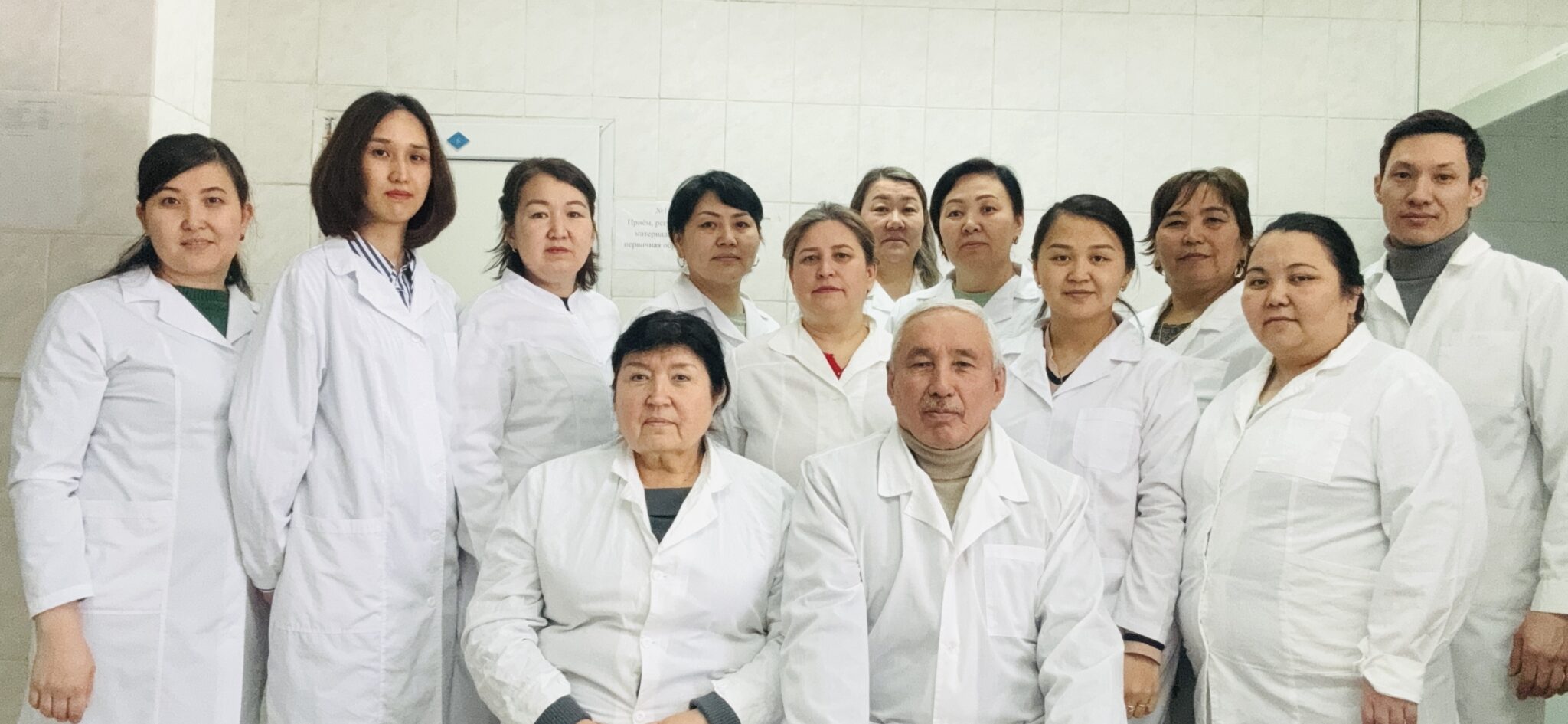
Head of the brucellosis laboratory is Candidate of Veterinary Sciences Bakieva Flura Albertovna.
Laboratory of brucellosis was opened in March 1938. The laboratory was headed at various times by scientists I.P. Derbedenev (1942-1946), K.S. Omarov (1946-1956), K.P. Studentsov (1956-1975), N.P. Ivanov (1975-1998), V.B. Ten (1998-2009), S.A. Baramova (2009-2015), A.J. Myrzaliev. (2015-2018), Charypkhan D.N. (2018-2019), Matalipova M.M. (2019-2020), Adambayeva A.A. (2020-2023). Since 2024 the brucellosis laboratory has been headed by F.A. Bakieva.
Research directions and objectives:
– monitoring of the epizootic situation in modern conditions of the development of the livestock industry in order to establish the circulation of epizootic brucella strains and their migration routes in the territory of the Republic of Kazakhstan;
– preservation, reproduction and effective use of the brucella gene pool available in the laboratory museum; study of the peculiarities of the biological properties of cultures isolated from animals in different regions of the republic;
for the production of highly effective diagnostic and therapeutic medicines aimed at controlling brucellosis infection of animals;
– development of anti-brucellosis measures for use in veterinary practice, including highly effective tools for the diagnosis and prevention of brucellosis of animals created in the brucellosis laboratory.
The main activity of the brucellosis laboratory is the development and improvement of highly effective diagnostic and therapeutic medicines, as well as a scientifically based system of measures including methods of their application in veterinary practice in order to prevent the occurrence and spread of brucellosis infection among various animal species.
Main achievements
According to the results of scientific research conducted by the brucellosis laboratory, more than 600 scientific articles, more than 40 recommendations, 6 monographs, 10 posters and booklets, 10 brochures were published, 15 doctoral and 65 candidate dissertations were defended. More than 10 regulatory and technical documents for various biological products have been approved and prepared, and more than 70 copyright certificates have been received.
The result of scientific research is the
– development and improvement of technology
“Scientifically based system of measures for the prevention and elimination of brucellosis of farm animals in the republic” developed in different years (A.A. Studentsov, A.Ya. Dzerzhinsky, I.F. Zadorozhny, A.B. Belchenko, N.P. Ivanov, V.A. Klimenko, M.S. Sarsenov, A.A. Sultanov, V.B. Ten, S.A. Baramova, R.D. Seydakhmetova, K.I. Minzhasov, A.L. Vorobyov, N.N. Zinina, E.S. Khasenov).
Under the supervision of Professor Abutalip A.A., a “Animal Brucellosis Control Strategy” has been developed in collaboration with the requirements of the Office International des Epizooties (OIE).
Under the guidance of Professor Baramova Sh.A., diagnostic medicines for serological studies of animals for brucellosis have been developed and proposed, 5 of which have registration certificates of the Ministry of Agriculture of the Republic of Kazakhstan and are sold by state order. There was developed a domestic diagnostic PCR test kit to detect animals infected with B. melitensis and B. abortus species. The use of this kit in diagnostic veterinary laboratories makes it possible to rapidly differentiate the two main types of brucella, the most pathogenic for animals and humans.
According to the scientific project “Molecular genetic typing of brucella strains circulating in the territory of the Republic of Kazakhstan using multilocus analysis of a variable number of tandem repeats (MLVA)”, genotypic
characteristics of brucella isolates isolated from animal biomaterials were determined.
At the moment, work is underway to establish cooperation with Istituto Zooprofilattico Sperimentale Abruzzo e Molise “G. Caporale” (Teramo, Italy) in the field of joint interlaboratory comparison tests for the development of a national standard serum for diagnostic studies in brucellosis.
Scientific publications
- Grushina T., Atshabar B., Syzdykov M., Daulbaeva S., Tserelson L., Kuznetsov A., Baramova Sh., Seidakhmetova R., Sultanov A., Ospanov Y., Mikhalev A., Amireev S., Ospanov K., Kazakov S., Mizanbayeva S., Myrzabekov A., Rementsova M., Berezovskiy D., Akasheva R., Khasenov M., Nussipova Zh., Yu W., Nielsen K. Universal indirect enzyme-linked immunosorbent assay for monitoring of human and animal brucellosis in Kazakhstan // Vaccine. – 2010. – V.28 (Suppl.5). – P. F46-F48. doi: 10.1016/j.vaccine.2010.03.052. Epub 2010 Apr 1. PMID: 20362617.
- Duriya Charypkhan, Akhmetzhan A. Sultanov,P Ivanov, Sh. A. Вaramova, Torgerson P.R. Economic and health burden of brucellosis in Kazakhstan // Journal Zoonoses Public Health.-2019. Р.1-8 (IF-2,688).
3. Adambaeva A.A., Myrzaliev A.ZH., Tүsіpқanұly O., Kydyrova G.N. Sposob
polucheniya brucelleznoj syvorotki dlya provedeniya diagnosticheskih issledovanii pri brucelleze zhivotnyh // Nauchno-prakticheskij zhurnal «Uchenye zapiski» Kazan’, RF. – 2023. – T. 253 (1), – S. 10-16. DOI 10.31588/ 2413_4201_1883_1_253_10.
- Adambayeva A.A., Sultanov A.A., Nam I.Ya., Zayakin V.V. Allelic polymorphisms of the BoLA-DRB3 gene and resistance to brucellosis in Kazakh cattle // Veterinaria Italiana, Istituto Zooprofilattico Sperimentale dell’Abruzzo e del Molise, Teramo, Italy – 2022. – V. 58(2), ISSN 1828-1427, Р. 225–230. DOI assigned is: 10.12834/VetIt.2528.15313.1.
- Abutalip A.A., Daugaliyeva A.T., Otarbayev B.K., Daniyal A.K. Comparative effectiveness of methods of indication and identification of pathogens of brucellosis of animals / Scientific and practical journal of Zhangir Khan West Kazakhstan Agrarian – Technical University, 2022. – № 3-1 (68). – Р. 148-156.
- Baramova SH.A., Abutalip A.A., Kanatbaev S.G. Ajtkulova A., Atovulozoda R.A., Rasulov S.A., Radzhabov H.I. Analiz epizooticheskoj situacii po brucellezu KRS v Respublike Kazahstan za poslednie 3 goda // Izvestiya Akademii nauk Respubliki Tadzhikistan. Otdelenie biologicheskih i medicinskih nauk. – Dushanbe, 2020. – №2 (209). – S. 68-78.
7. Ә. Әбутәліп, А.Ж. Мырзалиев, О. Түсіпқанұлы, Г. Қыдырова. Жануарлар бруцеллезін КБР балау тиімділігі // Научный журнал «Биобезопасность и биотехнология»
РГП «НИИПББ». – 2020. – №1. – С 12-45.
- Baramova SH.A., Rasulov S.A., Turaev R.A., Myrzaliev A.ZH., Radzhabov H.I., Mirzoev D.M. Effektivnost’ edinogo cvetnogo antigena KazNIVI pri diagnostike brucelleza zhivotnyh // Izvestiya Akademii nauk Respubliki Tadzhikistan. – Otdelenie biologicheskih i medicinskih nauk. – Dushanbe, 2019. – №3 (206). – S. 67-73.
- Daugalieva A.T., Baramova SH.A., Userbaev B.S., Adambaeva A.A., Daugalieva S.T., Ajtlesova R.B. Geneticheskoe raznoobrazie shtammov Brucella melitensis i Brucella abortus, vydelennyh ot lyudej i zhivotnyh razlichnyh oblastej Kazahstana // ZH. «Mikrobiologiya i virusologiya». – Almaty, 2019. – №1 (24). – S. 24-32.
- Daugaliyeva A., Sultanov А.А., Usserbaev D., Baramova Sh., Adambaeva А. et al. Genotyping of Brucella melitensis and Brucella abortus strains in Kazakhstan using MLVA-15» // Journal Infection, Genetics and Evolution. – 2018. – V. 58. – Р. 135-144.
- А. Abutalip, N. Matikhan, S. Kanatbayev, M. Bazarbayev, V. Vorobyov. Analysis of efficiency of vaccines against brucellosis in cattle in the republic of Kazakhstan // Asian journal of Pharmaceutical and Clinical Research. – 2017. – V. 10б, lssue 6. DOI: 10.22159/ajpcr.2017.v10i6.16594.
- Sovremennye problemy veterinarnoj mediciny / – Uchebnik v chetyrekh tomah / Berkinbaj O., Abutalip A., Kanatbaev S.G., Husainov D.M. – Almaty, 2017. – 868 s.
e-mail: flurachka-78@mail.ru
Laboratory of Virology
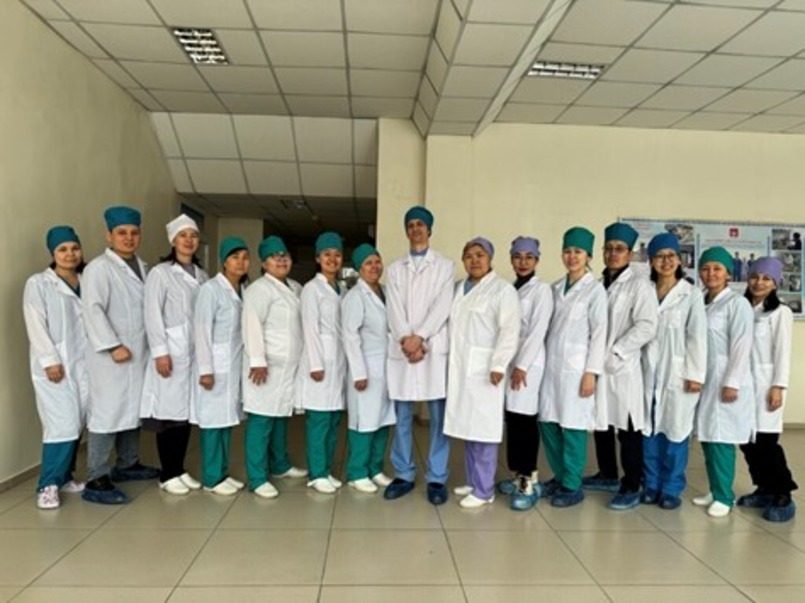
Head of the Virology Laboratory is Dr. PhD Nisanova Raikhan Kuanovna.
Laboratory of Virology was organized in 2012 by combining the foot-and-mouth disease laboratory (1936), the Laboratory of Avian diseases (1961) and the Laboratory of Virology (1959).
The first head and founder of the Virology Laboratory was Candidate of Veterinary Sciences A.A. Palgov, then it was headed by Doctor of Veterinary Sciences, Professor K.N. Buchnev and Doctor of Veterinary Sciences G.A. Kolomakin.
From 1974 to 1995, the laboratory was headed by Doctor of Veterinary Sciences, Professor N.N. Gizitdinov; in 1995-1998 – Candidate of Biological Sciences J.O. Omirzhanov; in 1998-2000 – Candidate of Veterinary Sciences L.B. Kutumbetov; in 2000-2004 – Candidate of Veterinary Sciences Y.H. Bakhtakhunov; in 2004-2012 – Candidate of Veterinary Sciences A.A. Abishov; in 2012-2018 – Doctor of Veterinary Sciences, Associate Professor L.B. Kutumbetov; in 2019-2022 – Master of Agricultural Sciences M.A. Saduakasova; in 2023-2024 – Candidate of Veterinary Sciences V.V. Kirpichenko; since 2025, the virology laboratory is headed by Dr. PhD Nisanova Raikhan Kuanovna.
Research directions and objectives:
Disease diagnostics: Detection and identification of pathogens using PCR (polymerase chain reaction), ELISA and virus isolation on virological cultures.
Disease monitoring: Active information monitoring of the spread of infectious diseases among animals inside and outside the country and providing data on disease incidence.
Research and development: The Laboratory of Virology is engaged in scientific research aimed at developing new diagnostic methods, national standards, vaccines, strategies and methods for the control of animal infectious diseases.
Training and consultations: The Virology Laboratory provides training programs for veterinary specialists, undergraduate and graduate students and advises practicing veterinarians and economic entities on the diagnosis and control of infectious diseases.
Analysis and forecasting: The laboratory participates in epizootological monitoring and data analysis, which allows timely detection and prevention of disease outbreaks, and predicting their possible development.
Main achievements
During the period of the laboratory’s existence, its employees have developed and implemented:
– a manufacturing method of anti-foot-and-mouth disease serum and citrated blood of convalescents,
which was included in the instruction on FMD control;
– a method for diagnosing rabies using precipitation reaction in agarose gel;
– homologous anti-rabies vaccine against canine rabies;
– preventive measures and treatment of viral respiratory and gastrointestinal diseases of young cattle;
– polyvalent immunolactoserum against calf pneumoenteritis, which has 85-90% preventive and curative effect;
– vaccine manufacture technologies against equine herpesvirus infection, rabbit viral hemorrhagic disease, sheep and goat pox;
– 12 methodological recommendations aimed at combating and preventing infectious diseases of animals, including especially dangerous ones;
– Strategy for the control of foot-and-mouth disease in animals;
– Self-declaration on avian influenza;
– panel of standard national serums for bovine leukosis;
– diagnostic test system for detection of avian influenza virus in RT-PCR.
The Virology Laboratory has permission to handle pathogens of II-IV group pathogenicity, accreditation area according to ISO/IEC – 17025-2019 standards, is a provider of proficiency testing of diagnostic laboratories and organizes rounds of comparison tests both at national and international levels.
The laboratory conducts research (scope of accreditation):
RNA detection of avian influenza virus type A by real-time RT-PCR;
RNA detection of avian influenza virus subtypes H5 and H7 by real-time RT-PCR;
RNA detection of Newcastle disease virus by real-time RT-PCR;
detection of antibodies to avian influenza virus by enzyme immunoassay;
detection of antibodies to Newcastle disease virus by hemagglutination inhibition reaction;
detection of antibodies to avian influenza virus by hemagglutination inhibition reaction;
detection of antibodies to Newcastle disease virus by immunoassay method;
detection of antibodies to bovine leukosis virus by immunoassay method;
detection of antibodies to lumpy skin disease virus by immunoassay method;
detection of antibodies to avian infectious
laryngotracheitis virus;
detection of antibodies to avian infectious bronchitis virus.
Scientific relations have been established with the Veterinary Research Institute “OIE National Reference Laboratory for Bovine Leukosis” (Piwet, Poland), OIE / FAO FMD Pirbright Institute (UK), FGBI “ARRIAH” (Russia).
Scientific publications:
- Turgenbaev K.A, Abdybekova, A.M, Borsynbayeva, Kirpichenko V.V, Aiken S. Karabassova, Yerzhan Ospanov Saltanat Mamanova Perizat Akshalova Elvira Bashenova Saira Kaymoldina Marat Turkeev Bakhit Tulepov. Development and planning of measures to reduce the risk of the foot-and-mouth disease virus spread (case of the Republic of Kazakhstan). // Caspian journal of Environmental Sciences, ISSN 1735-3033. – July 2023. – Volume 21, Issue 3. – P. 561-573. doi.10.22124/CJES.2023.6933.
- Aneta Pluta, Tasia Marie Taxis, Frank van der Meer, Sulav Shrestha, Dominic Qualley, Paul Coussens, Marzena Rola-Łuszczak, Anna Ryło, Ali Sakhawat, Saltanat Mamanova, and Jacek Kuźmak. An immunoinformatics study reveals a new BoLA-DR-restricted CD4+ T cell epitopes on the Gag protein of bovine leukemia virus. // Sci Rep 13, 22356 (2023). https://doi.org/10.1038/s41598-023-48899-4. (Q1 в WoS, процентиль 78)
3. Кирпиченко В.В., Бакиева Ф.А., Маманова С.Б., Оспанов Е.К., Каймолдина С.Е.
Эпизоотическая ситуация по инфекционному ринотрахеиту крупного рогатого скота в Карагандинской области, Республика Казахстан, в 2021-2022 годах // Ветеринария сегодня. – 2023-09 DOI: 10.29326/2304-196X-2023-12-3-233-239
- Ospanov Y.K., Kanatbayev S.G., Akshalova P.B., Mamanova S.B., Bashenova E.E., Karabassova A.S., Kaymoldina S.Y. Risks of occurrence and spread of lumpy skin disease virus in the republic of kazakhstan // Научно-практический журнал Западно-Казахстанского аграрно-технического университета имени Жангир хана «Ғылым жəне білім». – 2023. – №1-1/70. – С.. 97-105. https://doi.org/10.52578/2305-9397-2023-1-1-97-105.
- Карабасова А.С., Тургенбаев К.А., Оспанов Е.К., Башенова Э.Е., Маманова С.Б., Алиханов К.Д., Жусупбеков Ж.С., Туркеев М.К., Борсынбаева А.М. Иммуногенность противоящурных вакцин применяемых в Казахстане. // Научнo-практический журнал Западно-Казахстанского аграрно-технического университета имени Жангир хана, «Ғылым және білім». – 2023. – Т. 2. – №2-2(71). С. 39-47,
6. Кирпиченко В.В., Бакиева Ф.А., Маманова С.Б., Оспанов Е.К., Каймолдина С.Е. Эпизоотическая обстановка по инфекционному ринотрахеиту крупного рогатого скота в Карагандинской области Республики Казахстан в 2021–2022 гг. // Ветеринария
сегодня. ФГБУ «Федеральный центр охраны здоровья животных». Москва, 2023; – 12(3): – С. 233–239. DOI: 10.29326/2304-196X-2023-12-3-233-239.
- Башенова Э.Е., Нисанова Р.К., Жусупбеков Ж.С., Бегасыл К.С., Садуакасова М.А., Қарабасова А.С., Алиханов Қ.Д. «Құс тұмауы вирусына антиденелерді анықтау үшін серологиялық әдістерді кешенді пайдалану және стандартты қан сарысуына үлгілерді таңдау» // в Науч.- практ. Журнал ЗКАТУ имени Жангир хана «Ғылым және білім» – 2023. – Т. 3. – № 2-1 (71). – С.29-36.
- Akhmetzhan Sultanov, Marzena Rola-Łuszczak, Saltanat Mamanovа, Anna Ryło, Zbigniew Osi ́nski, Meruyert A. Saduakassova, Elvira Bashenova and Jacek Ku ́zmak. Molecular Characterization of Bovine Leukemia Virus with the Evidence of a New Genotype Circulating in Cattle from Kazakhstan // Journal Pathogens. – 2022. – Р 11(2):180. (https://doi.org/10.3390/pathogens11020180).
- Nesterov, A.; Mazloum, A.; Byadovskaya, O.; Shumilova, I.; Van Schalkwyk, A.; Krotova, A.; Kirpichenko, V.; Donnik, I.; Chvala, I.; Sprygin, A. Experimentally controlled study indicates that the naturally occurring recombinant vaccine-like lumpy skin disease strain Udmurtiya/2019, detected during freezing winter in northern latitudes, is transmitted via indirect contact // Frontiers in Veterinary Science. – 2022. DOI: 10.3389/fvets.2022.1001426.
10. Aiken S. Karabassova, Akhmetzhan A.
Sultanov, Meruyert A. Saduakassova, Donald P. King, Anna B. Ludi, Clare F. J. Browning and Ginette Wilsden. Toward the calibration of serological assays using sera collected from cattle and sheep following a single dose of foot-and-mouth disease vaccine. // Veterinary World. – 2022. – V. 15. – P. 524-530. www.doi.org/10.14202/vetworld.2022.524-530.
- Zinyakov, N.G., Sosipatorova, V.Y., Andriyasov, A.V., Akshalova, P.B. [et al.] Genetic analysis of genotype G57 H9N2 avian influenza virus isolate A/chicken/Tajikistan/2379/2018 recovered in Central Asia // Arch Virol. – 2021. – N 166 (6). – P. 1591–1597. DOI: 10.1007/s00705-021-05011-3.
- П.Б. Акшалова, А.В. Андриясов, Л.О. Щербакова [и др.] Разработка метода ОТ-ПЦР в режиме реального времени для выявления РНК вируса гриппа птиц подтипа N2 // Ветеринария сегодня. – 2020. – №3 (34). – С. 186–192. DOI: 10.29326/2304- 196X-2020-3-34-186-192.
- Патент «Способ получения сыворотки для проведения диагностических исследований при болезни Ньюкасла». Патент №7287 (21) 2022/0394.2. авт. Жусупбеков Ж.С., Садуакасова М.А., Байкара Б.
14. Патент «Способ получения сыворотки для проведения диагностических исследований при гриппе птиц». Патент №7496 (21) 2022/0393.2. авт. Жусупбеков Ж.С., Садуакасова М.А., Байкара Б.
e-mail: vlad_92reik@mail.ru
Laboratory of Molecular Genetics and Food Safety
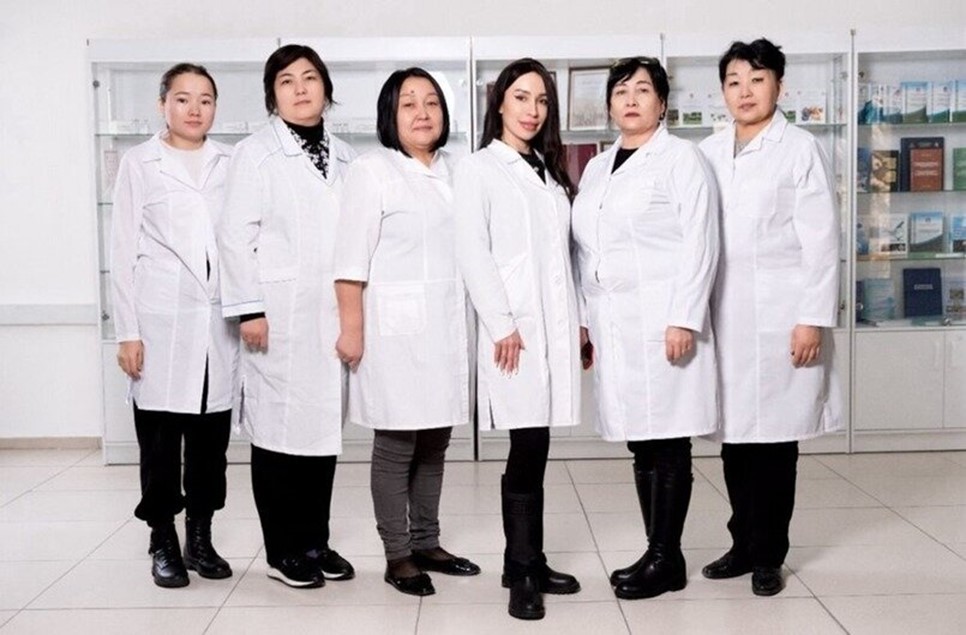
Head of the Laboratory of Molecular Genetics and Food Safety – Master of Science Abay Zhandos Sailaubekuly.
The Laboratory of Molecular Genetics and Food Safety was organized in 2015 on the basis of laboratories: biotechnology and immunology (2004-2008; 2009-2012); analytical laboratory (2008-2009); laboratory of food safety (2012-2015); laboratory of molecular genetics of microorganisms, biochemistry and immunology (2015-2023), since 2024 renamed as the laboratory of molecular Genetics and food safety.
In different years, the laboratories were headed by Sh.A. Baramova (2004-2008), Sh.T. Sarbakanova (2009-2015), A.T. Daugalieva (2015-2017), B.S. Userbayev (2018-2021), A.S. Slyamova (2021-2022), Z.A. Latypova (2023-2024). Since 2025, the laboratory headed Master of Science Abay Zh. S.
Research directions and tasks:
conducting molecular genetic studies to identify pathogens of infectious animal diseases (aphthae, brucellosis, leukemia, salmonellosis, pasteurellosis, etc.);
development of modern analytical methods for the detection of biological agents and toxins of chemical pollutants in food and agricultural crops;
food safety monitoring;
determination of GMOs in feed, animal and vegetable products;
specific identification of the raw material composition of meat and meat products;
determination of antibiotics, pesticides, mycotoxins in food products, raw materials of animal and plant origin by immunological methods;
hematological and biochemical analysis of animal blood;
The main activity of the laboratory is the development of analytical control methods and monitoring of food safety, improving the effectiveness of quality control and safety of products and raw materials of animal origin.
Main achievements:
The laboratory is accredited in accordance with the procedures of the State System of Technical Regulation of the Republic of Kazakhstan, GOST ISO/IEC 17025 “General requirements for the competence of testing and calibration laboratories” and provides services to determine compliance with the requirements of “Halal”: determination of the mass fraction of alcohol in soft drinks and kvass drinks; determination of
the raw composition of meat products by molecular genetic express method.
A programme for controlling the food safety of livestock products at all stages of “production-consumption” has been developed; science-based proposals for veterinary and sanitary assessment of livestock products, including the introduction of international HACCP principles; a National action Plan to curb antimicrobial resistance and its scientific support; the scientifically justified maximum permissible standards for the content of veterinary drugs (antibiotics, anthelmintics, etc.) in products and raw materials of animal origin, feed and feed additives, for which the MAC in the EAEU has not been established, in accordance with approved international standards, have been determined.
According to the results of scientific research conducted by the laboratory, more than 130 scientific articles have been published, 18 patents have been obtained (2010-2024).
Developed:
methodological recommendations for the control of products of plant and animal origin, feed and feed additives obtained using GMOs;
methodological recommendations for studying the genetic structure of walleye populations using DNA markers;
methodological recommendations on DNA extraction from the fins of sturgeon fish;
methodological recommendations for the rational use of antibiotics in agricultural production and veterinary medicine;
methods, principles and procedure for forecasting outbreaks of cattle pasteurellosis and planning veterinary and preventive measures: target indicators of the effectiveness of veterinary measures, including taking into account risk analysis and assessment;
methodological guidance on the system of improving the effectiveness of veterinary and sanitary measures for cattle pasteurellosis;
methodological guidance zoning and regionalization of the territory of the Republic of Kazakhstan according to the degree of intensity of the epizootic situation of pasteurellosis;
method for the determination of dioxins in feed, feed additives and animal products;
bioluminescent rapid test for the determination of mycotoxins in products of plant and animal origin;
methodological recommendations on the use of bioluminescent biotests for the detection (rapid testing) of mycotoxins in products of plant and animal origin;
Scientific publications:
1. Buienbayeva Z. K., Latypova Z. A., Issakulova B. Zh., Name A.M., Makbuz A. Zh., Vladoska A. Development of Veterinary and
Sanitary Measures for the Prevention of Pasteurellosis Infection in Cattle: The Case of the Republic of Kazakhstan // International Journal of Veterinary Science. – 2024. – 13. – N. 2, Р. 164-171.
- Buienbayeva Z. K., Latypova Z. A., Issakulova B. Zh., Name A.M., Makbuz A. Zh., Seytzhanova U. U. Biological properties of circulating strains of Рasteurella multocida in the territory of the republic of Kazakhstan // Journal «Science and Education» – 202 – №1-1 (70). – С. 59-65.
- Yegorova N. N., Sarbakanova Sh. T., Kerimbaeva R.А. «Study of antibiotic sensitivity of pathogenic microorganisms – causative agents of infectious diseases of farm animals» Scientific research of the SCO countries: Synergy and Integration International Conference Beijing, China, – 2020, – С. 73-80.
- Latypova Z.A.,Sarbakanova Sh. T.,Egorova N.N., Kerimbaeva R.А., Shakibayev Y., Serikkyzy Z. Characteristic of Listeria monocytogenes, isolated from the meat of different species of animals // International conference on agronomy and food science & technology AGROFOOD 20 – 21 June 2019, Istanbul, P. 245 – 250.
- Daugaliyeva A., Sultanov А.А., Usserbaev D., Baramova Sh., Akmaral Adambaeva et al. Genotyping of Brucella melitensis and Brucella abortus strains in Kazakhstan using MLVA-15 // Journal Infection, Genetics and Evolution. – 2018. 58. – Р. 135-144.
- Latypova Z.A., Sarbakanova Sh.T., Sultanov A.A., Nam I.Yan., Zayakin V., Smaznova I., Kozlov A., Mamanova S. Comparison between Populations of Black Pied and Holstein Cows and Stud Bulls from Russia, Belarus and Kazakhstan by the Genetic Markers for Resistance to Leukemia // International Journal of Current Research in Biosciences and Plant Biology. – 2017. – V. 4. – N. 8. – Р. 1-7.
- Latypova Z.A., Sarbakanova Sh.T., Sultanov A.A., Nam I.Yan., Zayakin V., Akhmedov R., Smaznova I., Egiazaryan A., Sheiko A., Budevich A. DNA-Polymorphism of the BoLA-DRB3 Gene in Crossbreeding of Holstein and Black Pied Cattle from the Bryansk Region of Russia, Belarus and Kazakhstan // Current Science. – 2017. – V. 112. – N.10. – С. 1-14.
- Аida Daugaliyeva, Simone Peletto, Akhmetzhan Sultanov, Sholpan Baramova, Pier Luigi Acutis, Akmaral Adambaeva, Oralkan Tusipkanuly, Bekbolat Usserbayev. Development of a Differential PCR Assay for Detection of Brucella abortus and Brucella melitensis // Journal of Food Quality and Hazards Control. – 2016. – № 3. – Р. 53-59.
- Latypova Z.A., Sarbakanova Sh.T., Esimbekova E.N., Kasymova K.T. Sensitivity analysis of luminescent bacteria to the action of pesticides of different nature // International Journal of Applied and Fundamental Research. – 2015. – № 2.
- Barmintseva, A.E., Shalgimbayeva, G.M., Koishybayeva, S.K., Sarbakanova Sh.T…..Isbekov, K.B., Mugue, N.S. Genetic study of pike perch Sander lucioperca (Linnaeus, 1758) and bersh Sander volgensis (Gmelin, 1789) from the fishery water-bodies of Kazakhstan // Russian Journal of Genetics. – 2014. – V. 50(7). – Р. 749-756.10. Aubekerova L.S., Sarbakanova Sh.T, Minaeff M.Yu. Development of primers and
probe for horseflesh PCR identification in meat products // International Journal of Applied and Fundamental Research. – 2015. – С. 2 – 3.
- Barmintseva, A.E., Shalgimbayeva, G.M., Koishybayeva, S.K., Sarbakanova Sh.T…..Isbekov, K.B., Mugue, N.S. Genetic study of pike perch Sander lucioperca (Linnaeus, 1758) and bersh Sander volgensis (Gmelin, 1789) from the fishery water-bodies of Kazakhstan // Russian Journal of Genetics. – 2014. – V. 50(7). – Р. 749-756.10. Aubekerova L.S., Sarbakanova Sh.T, Minaeff M.Yu. Development of primers and
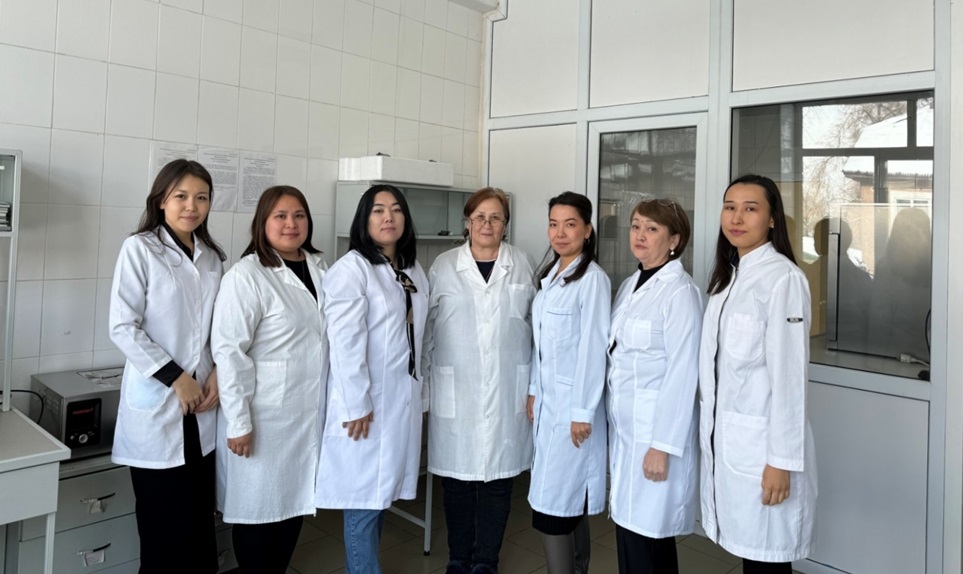
Laboratory of Parasitology and Mycology
Acting head of the Laboratory of Parasitology and Mycology – Dr. R. Zhaksylykova Ainur Abzalkyzy.
Laboratory of parasitology was founded in 1996 on the basis of helminthological laboratory (1926), laboratory of protozoology and arachnoentomology (1935). The founder of the laboratory of protozoology and arachnoentomology and its first head was Doctor of Biological Sciences, Professor A.A. Tselischev (1935-1950); then Candidate of Biological Sciences L.M. Tselischeva (1950-1957); Honoured Scientist of KazSSR, Doctor of Veterinary Sciences, Professor N.P. Orlov (1957-1961); Honoured Scientist of KazSSR, Doctor of Biological Sciences, Professor M.V. Khvan (1970-1985); Doctor of Biological Sciences, Professor M.S. Sabanshiev (1985-1993).
The Laboratory of Helminthology is one of the oldest, it was organized in 1926, headed by L.G. Panova; then it was headed by Doctor of Veterinary Sciences N.V. Badanin (1928-1932); academician of the Academy of Sciences of the Kazakh SSR S.N. Boev (1932-1955); academician of the Kazakh Academy of agricultural Sciences R.S. Schultz (1955-1967); Doctor of Veterinary Sciences, Professor G.I. Dikov (1967-1993); Candidate of Veterinary Sciences, Associate Professor M.Zh. Suleimenov (1993-2003, 2004-2014); Master Bulekulova Zh. (2018-2020), PhD Doctor Abdibaeva A.A. (2021-2023). Since 2023, the laboratory is headed by PhD Doctor Zhaksylykova A.A.
Research directions and objectives:
– study of parasitofauna of aquatic and terrestrial animals;
– development of antiparasitic medications;
– development of measures for prevention and devastation of parasitic diseases of animals.
The main activity of the Laboratory of Parasitology and Mycology is to conduct fundamental and applied research in the field of parasitology.
Main achievements
The laboratory staff has developed and implemented tools and methods for the prevention and therapy of echinococcosis, opisthorchiasis and other agents of zoonotic invasions:
– ” Preparation for mineral-salt feeding and dehelminthisation of domestic and wild animals “;
– “Anthelmintic for marals and deer”;
– “Preparation for the treatment and prevention of echinococcosis of carnivores”;
– “CesTremForte” for dehelminthisation of domestic and wild carnivores against echinococcosis, alveococcosis, opisthorchiasis and other helminthic diseases;
– Complex preparation “Fenasol”.
3 registration certificates were received, industrial production was established on the basis of KazSRVI LLP under the commercialization project. The preparations are sold in the retail network and under the state order.
The Laboratory of Parasitology and Mycology of the Kazakh National Research Institute is the only one in Kazakhstan accredited according to quality standards, has key links with all veterinary institutions of the country. The scope of accreditation of the testing laboratory includes 4 indicators:
– helminthiasis of animals;
– determination of eggs and larvae of parasites in fish and non-fish fishing objects (mollusks, crustaceans, amphibians, reptiles) as well as products of their processing;
– trypanosomiasis;
– epizootic lymphangitis.
Scientific relations have been established with the Institute of Parasitology and the Institute of Epidemiology of the University of Zurich (Zurich, Switzerland), the All-Russian Research Institute of Fundamental and Applied Parasitology of Animals and Plants named after K.I. Scryabin (Moscow, Russia), the Scientific Research Veterinary Institute of the People’s Republic of China (Urumqi, China) and etc.
Currently, the laboratory conducts unique research on the biology of pathogens of parasitic diseases, the creation of diagnostic and preventive methods, new tools for deworming of agricultural, domestic and wild animals, taking into account the species composition of parasites circulating in the territory of the Republic of Kazakhstan.
Molecular genetic studies (PCR, sequencing) are carried out to determine the type of pathogen.
The species composition of parasites of domestic and wild animals, commercial fish of the Caspian Sea, the Small Aral Sea, the Zhaiyk River and other natural reservoirs of the republic are being studied.
They also study the species composition of parasitic gadfly and ixodid ticks, their habitats, biology and phenology.
Scientific publications:
- Abdybekova A.M., Zhaksylykova A.A., Kushaliyev K.Zh, Kidiraliyev E.Zh, Kozhayeva A.R., Kuzhebayeva U.Zh, Grachev A., Shevtsov A., Budke Ch.M. A survey of the parasites of Ural saiga antelopes and Turkmenian kulans of Kazakhstan // International Journal for Parasitology: Parasites and Wildlife. – August 2023 – V. 21. https://doi.org/10.1016/j.ijppaw.2023.06.006.
- Turgenbayev K., Abdybekova A., Borsynbayeva A., Kirpichenko V., Karabassova A., Ospanov Y., Mamanova S., Akshalova P., Bashenova E., Kaymoldina S., Turkeev M., Tulepov B. Development and planning of measures to reduce the risk of the foot-and mouth disease virus spread (case of the Republic of Kazakhstan) // Caspian Journal of Environmental Sciences. – 2023. – V. 21. – No. 3. DOI: 10.22124/CJES.2023.6933.
- Sayakova Z. Z., Kalmakova M. A., Abdybekova A. M., ZHaksylykova A. A., Nurmaganbetov N. A., SHakiev N. N. Kleshchi roda haemaphysalis koch, 1844 (ixodidae, amblyomminae) v Kyzylordinskoj oblasti // Gylym zhane bіlіm. – 2023. – № 2-2 (71). DOI 10.56339/2305-9397-2023-2-2-47-62, S.47-61.
- Aubakirov M. Zh., Abdybekova A. M., Asylkhanovna M. Kh., Issabayev A. Zh., Kaumenov N.S., Tegza A.A., Sapa V.A., Domatsky V. N., Erenko E.N., Namazbai K.N. Epizootology and Epidemiology of Opisthorchiasis in Northern Kazakhstan // OnLine Journal of Biological Sciences. – 2022. – № 22 (3).
- Abdybekova A.M., Assylbekova S.Zh., Abdibayeva A.A., Zhaksylykova A.A., Barbol B.I., Aubakirov M.Zh., Torgerson P.R. Studies on the population biology of helminth parasites of fish species from the Caspian sea drainage basin // Journal of Helminthology (Cambridge University Press). – 2021.
- А.M. Abdybekova., A.A. Abdibayeva., N.N. Popov., A.A.Zhaksylykova., B.I. Barbol., B.Zh. Bozhbanov., P.R. Torgerson. Helminth Parasites of Fish of the Kazakhstan Sector of the Caspian Sea and Associated Drainage Basin // J. HELMINTHOLOGIA. – 2020. – Т. 57. – № 3. – P. 241 – 251.
- Abdybekova A.M., Zhuangzhi Zhang, Sultanov A.A., Abdibayeva A.A., Zhaksylykova A.A., Junisbayeva S., Aubakirov M., Akhmetova G.D., Torgerson P.R. Genotypes of Echinococcus isolated from domestic livestock in Kazakhstan // Journal of Helminthology. – 2019. – P. 1 – 3. DOI: 10.1017/S0022149X19000634.
- Abdybekova A.M., Abdibaeva A.A., Popov N.N., ZHaksylykova A.A., Barbol B.І., Bozhbanov B.ZH. Parazitofauna ryb ZHajyk-Kaspijskogo bassejna // Monografiya.- Atyrau, 2019. – S. 257 – 274.
- Abdybekova A.M., Abdibaeva A.A., Popov N.N., ZHaksylykova A.A., Barbol B.І., Bozhbanov B.ZH. Parazitofauna morskih vidov ryb s uchetom ih biologicheskih pokazatelej, obitayushchih v shel’fovyh zonah severo-vostochnoj chasti Kaspijskogo morya // Mat.V mezhd. nauch. – prakt. konf. molodyh uchenyh i specialistov «Ekologo-biologicheskie problemy ispol’zovaniya prirodnyh resursov v sel’skom hozyajstve» – Ekaterinburg, Ural’skoe izdatel’stvo. – Ural’sk, 2019. – S. 197 – 203.
- Abdibaeva A.A., Popov N.N., ZHaksylykova A.A., Barbol B.I., Bozhbanov B.ZH. Soltүstіk – shyғys Kaspij teңіzdіk balyқtarynyң zoonozdy invaziyalary // Nәtizheler іzdenіster. – Almaty, 2018. – №3 (079) – S .5 – 10.
e-mail: ainusik_jan_91
Branches
West Kazakhstan Scientific Research Veterinary Station

Head of the branch
Kanatbayev Serik Ganievich
“West Kazakhstan Scientific Research Veterinary Station” branch of KazSRVI LLP is the firstborn of Kazakh science, founded on June 13 (25), 1896 on the basis of the Central Bacteriological Laboratory of the Ural region (it has been operating in Uralsk for 127 years).
Thus, the West Kazakhstan SRVS is the first scientific research institution in Kazakhstan.
The initiator of the opening of the central laboratory is Anatoly Petrovich Petrovsky, head of the veterinary department of the Ural region.
In different years, the West Kazakhstan SRVS was led by V.S. Anisimov (1944-1954), P.I. Ostrovidov and A.P. Shatrov. The directors of the West Kazakhstan Scientific Research Veterinary Station were A.S. Zhumashev (1973 – 1983), A.F. Ilyasov (1983 – 1985), K.M. Yerbolatov (1985 – 1987), M.Sh. Shalmenov (1987 – 2006), S.G. Kanatbayev (2006 – 2012), E.K. Tuyashev (2012-2013, 2015-2023), R.A. Amanzhol (2013 – 2015), from 2023 to the present, S.G. Kanatbayev is the head of the West Kazakhstan Scientific Research Veterinary Station branch.
The laboratory studied infectious diseases of farm animals (anthrax, glanders, actinomycosis, bovine lung inflammation, foot-and-mouth disease, emphysematous carbuncle). The central laboratory had 4 steppe departments and 5 field laboratories. Steppe branches were opened in the villages of Temir and Uil of Aktobe region, in the village of Jambeita and in Guryev. Field bacteriological laboratories operated in the city of Ilek, in Kamensky, Furmanovsky, Chapaevsky and Taipak districts of the Ural region.
Before the October Socialist Revolution, the laboratory staff consisted of only 1 doctor and 2 paramedics. By 1931, the staff had increased to 4 veterinarians, and from 1965 to 1975, there were 38 full-time units in the West Kazakhstan SRVS, including 9 researchers.
In 1920, the bacteriological laboratory was renamed the veterinary bacteriological laboratory of the veterinary sub-department of the regional Department of agriculture.
The laboratory provided the territory of the Ural province with such necessary therapeutic and prophylactic drugs as mallein, tuberculin and anthrax serums. Later, the annual reports of the bacteriological laboratory began to be published.
During the civil war, infections such as plague, emcar, anthrax, and tuberculosis were rampant in the province. The Ural Bacteriological Laboratory has played a huge role in the fight against these epizootics (S.A. Amanzholov, A.I. Zhuravlev, V.S. Anisimov, M.A. Chabarova).
In 1932, the Ural Veterinary and Bacteriological Laboratory was renamed the veterinary and bacteriological zonal station.
A year later, the station was reorganized into a scientific research veterinary and bacteriological laboratory for the study of camels, while laboratory staff studied epizootology and diagnostic methods for trypanosomiasis and brucellosis among camels of Atyrau and Ural regions.
Later, by resolution of the Council of People’s Commissars of the USSR dated 02/01/1935 No. 175, the laboratory was reorganized into the West Kazakhstan Scientific Research Veterinary Experimental Station.
During the reorganization of agricultural institutions, the Ministry of Education and Science of the Republic of Kazakhstan established the RSE “West Kazakhstan Scientific Research Veterinary Station” (Government Decree dated 07/20/1999).
Currently, the West Kazakhstan SRVS is a branch of KazSRVI LLP.
In different years, the scientific staff of the station conducted research of both scientific and practical importance.
In 1975, the station had laboratories for the study of helminthic diseases, brucellosis, leptospirosis, tuberculosis and diseases of young animals, a nursery for breeding rabbits, guinea pigs and white mice, its own experimental base with an area of 620 hectares. By this time, employees of the West Kazakhstan SRVS had completed 234 works, 88 of them from 1970 to 1975.
From 2021 to 2023, the West Kazakhstan Scientific Research Veterinary Station conducted scientific research within the framework of the STP ” To study the epizootological characteristics of the country’s territory in terms of especially dangerous diseases and to develop veterinary and sanitary measures to improve their effectiveness.”
With the active participation of researchers from the West Kazakhstan SRVS, it was possible to completely rehabilitate the territory of the West Kazakhstan region from bovine tuberculosis.
In 1980-2023, the scientific staff of the station defended more than ten candidate’s and doctoral dissertations, published hundreds of scientific articles, issued more than 50 recommendations and guidelines, 2 monographs, 2 scientific and technical documentation and more than 20 copyright certificates.
South Kazakhstan Scientific Research Veterinary Station

Head of the branch
Lesov Berik Yeltaevich
The branch of KazSRVI LLP South Kazakhstan Scientific Research Veterinary Station was established on the basis of the regional veterinary laboratory in accordance with the order of the Council of Ministers of the Kazakh SSR No. 538 dated May 12, 1940.
In 1946, the South Kazakhstan Scientific Research Veterinary Station, located in the city of Shymkent, became part of KazSRVI.
The first director was N.G. Pivinsky, Candidate of Veterinary Sciences. The work of the SRVS was aimed at developing ways to eliminate infectious and parasitic diseases of farm animals.
In different years, the South Kazakhstan SRVS was led by M. Zhanbyrbayev (1995 to 2006); M. Kozhabaev (2006-2013); J.K. Tuganaev (2013-2023). Since March 1, 2023, Lesov B.E has been acting as the head of the SRVS.
Scientists of the branch of the South Kazakhstan Scientific Research Veterinary Station studied the features of regional epizootology, biology, prevention, treatment and diagnosis of infectious pleuropneumonia of horses, infectious pleuropneumonia of goats, enterotoxemia, echinococcosis, sheep cenurosis, teileriosis, and developed measures to prevent them.
The scientists of the station have made a great contribution to the elimination of brucellosis and tuberculosis in cattle. By the end of 1995, the incidence of brucellosis in cattle decreased from 1.9 to 0.5%, and in sheep from 0.8 to 0.1%.
As a result of the work, the staff of the station developed anatoxin vaccines for production, standard serums for the diagnosis of the perfringens class, a scheme of a set of measures to combat echinococcosis and cenurosis of animals, methods of vaccination against teileriosis, brucellosis diagnosticums.
34 methodical guidelines, recommendations and training manuals on control of especially dangerous animal diseases have been published, 12 patents, 8 certificates of authorship, 4 references to rationalization proposals have been obtained, about 540 articles have been published..
In the South Kazakhstan Veterinary Research Station, 3 laboratories (brucellosis, tuberculosis and parasitology) were organized, in which 1 doctor of sciences, 2 candidates of sciences, 2 junior researchers and 1 laboratory assistant worked. Famous scientists worked at the station during the formation: Professor Tselishchev A. A. and Ulyanov V. I., doctors of sciences: Amanzholov, Ermolova, Gradoyan, Lenkov V. A., Baydaliev A. B., Doszhanov D. T., Kushchenko Z. V., Bayburiev M. B., Lakho V. P., Berkovich R. D., Borisov V. S., Aktaev A., Merkulov B.V., junior researchers: Yaremenko T. P., Taldakhmetov Sh., Yakubo E. P. and other scientists.
To date, South Kazakhstan SRVS employs a director, three junior researchers, a sanitarian, security guards and a driver of official vehicles.
The staff of the South Kazakhstan Veterinary Research Station monitors particularly dangerous infectious diseases of animals, scientific research on measures for the prevention, diagnosis and treatment of various infectious, non-infectious and parasitic animal diseases of the Turkestan and Kyzylorda regions. The scientists of the branch are engaged in the implementation of the obtained scientific results in animal husbandry, provide scientific and practical support to peasant farms, their recovery from infectious and parasitic diseases. Over the years, the branch carried out research on 019 BP MIO – introduced modern diagnostic methods and comprehensive measures to combat associative helminthiasis of farm animals; introduced “Echino STOP” tablets for the treatment and prevention of echinococcosis of carnivores.
The South Kazakhstan SRVS carries out its scientific and practical activities together with employees of regional and district veterinary services and local veterinary specialists engaged in laboratory studies of aphthae, nodular dermatitis, infectious rhinotracheitis, anaerobic enterotoxemia of small animals and sheep bradzote, pasteurellosis, echinococcosis and teniidiosis, anthrax, leukemia, moraxellosis and emcar.
Kostanay Scientific Research Veterinary Station

Head of the branch
Mustafin Batyrzhan Muafikovich
The Kostanay Scientific Research Veterinary Station was established in August 1957 by the Decree of the Council of Ministers of the Kazakh SSR (No. 1396-r dated August 28) for the development and implementation of applied research aimed at developing more advanced tools and methods of early diagnosis, treatment and prevention of animal diseases of infectious and non-infectious etiology, as well as integrated veterinary and preventive systems and sanitary measures aimed at ensuring the stable veterinary well-being of livestock farms and farms, protecting the environment from pollution, obtaining livestock products of high sanitary quality.
Since the founding of the Kostanay Scientific Research Veterinary Station, Grishaev N.E. (1957-1970), Piontkovsky V. I. (1970-2003), Kaiypbai B. B. (2003-2010), Kunakbaev T.M. (6 months of 2010), Mustafin B.M. (from 2010 to the present) have worked as directors.
Over the years, the scientific staff of Kostanay Scientific Research Veterinary Station has received 250 certificates of intellectual property for an invention, published more than 800 articles, developed more than 70 recommendations, published 30 monographs, defended 19 candidate’s and 10 doctoral dissertations.
Kostanay Scientific Research Veterinary Station has highly qualified scientific staff, successfully continuing the glorious creative traditions. Kostanay Scientific Research Veterinary Station has a laboratory of bacteriology and serology, PCR equipment, ELISA, and library. Lectures and seminars are held for practicing veterinary specialists. Round tables are held on the basis of the SRVS. The research work is being carried out successfully.
Cooperation in the field of veterinary medicine is carried out with all interested state bodies to prevent the spread of infectious animal diseases in the territory of Kostanay and North Kazakhstan regions.
Zhambyl Scientific Research Veterinary Station

Head of the branch
Tlepov Anarbek Amreevich
The Zhambyl Helminthological Research Laboratory named after Academician K.I. Scryabin was established by the decision of the Government of the Kazakh SSR in 1961 in the city of Zhambyl. Then, in 1992, the Zhambyl Veterinary Research Station was organized on its basis.
Since the founding of the Zhambyl SRVS, P.P. Vibe, G.K. Koishibaev, T.D. Sultankulov, S.Kazakhbayev, M. Berdigulov have worked as directors. Since 2013, the branch has been headed by Candidate of Agricultural Sciences A.A. Tlepov.
In 1961, a memorial House-museum named after Academician K.I. Scryabin was organized at the branch of the Zhambyl Veterinary Research Station, in 1962 it was visited by Academician K.I. Scryabin and his wife. Over the years, 2 doctoral theses have been defended (Vibe P.P., Radionov P.P.), 10 PhD theses (Sultankulov T.D., Kopbosynov B.K., Orynbaev B.O., Tishchenko V.V., Ergaliev K.E., Petrov V.S., Tishchenko L.G., Usenbaev A.E., Aliyev A.K., Kazakhbaev S.). More than 500 scientific articles have been published in academic scientific and popular periodicals on measures to combat helminthiasis of farm animals, more than 90 in newspapers of regional and district mass media, more than 40 recommendations and booklets, 1 methodological manual, 50 information materials, 31 posters, 8 books and 4 textbooks for universities approved by the Ministry of Science and Education Republic of Kazakhstan, 16 security documents have been received. More than 40 preparations against helminths of farm animals and dogs developed by employees of the branch have been experimentally tested and proposed for production. The research Station has developed and introduced into the farms of the Southern region 12 new drugs against parasites of farm animals and dogs (dexufen, fesun, femsunate, methionaft, aldex, anazoline, glypher, microdosed salt mixtures, altrim, calgid, anabazine, etc.).
Employees of the branch were awarded four medals named after Academician K.I. Scryabin, 12 certificates of honor and five medals of the All-Union Agricultural Exhibition of the USSR.
East Kazakhstan Scientific Research Veterinary Station

Head of the branch
Bapinov Tilek Bauyrzhanovich
The East Kazakhstan Scientific Research Veterinary Station was established in 1957 in the city of Ust-Kamenogorsk by order of the Council of Ministers of the Kazakh SSR. Candidate of Veterinary Sciences Ushakov V.T. was appointed director of the SRVS.
However, back in 1931, the Semipalatinsk zonal station worked in Semipalatinsk, which, during the reorganization of the research network, which took place in 1935, was turned into the Semipalatinsk Scientific and Practical regional laboratory and, in this regard, some of the workers from it were transferred to strengthen the KazSRVI.
In the early days of their activity, the scientific staff of the station were engaged in clarifying the causes of infertility of cows, organizing and implementing measures against cenurosis and echinococcosis in sheep farms of the republic, developing an accelerated method of improving farms disadvantaged by brucellosis and tuberculosis of farm animals.
Measures have been developed to control cenurosis, echinococcosis and helminthiasis of sheep and cattle (Kh. Satubaldin, 1958).
Since the beginning of the formation of the East Kazakhstan SRVS, there has been a laboratory for bovine tuberculosis. The percentage of tuberculosis in cattle by year, the type of mycobacteria isolated in different years and from different animal species were studied. To combat tuberculosis of farm animals, a “Comprehensive action plan for the rehabilitation of tuberculosis-affected farms” has been developed.
In 1962, the study of swine brucellosis was included in the station’s subject matter.
Since 1966, the staff has been studying the causes of widespread dyspepsia among newborn calves. It has been established that the main causes of acute gastrointestinal diseases of calves are virulent serotypes of E. coli (B.V. Merkulov).
In 1970, a laboratory for the study of brucellosis of agricultural animals with a staff of 7 people was re-organized at the station, the laboratory was headed by Yu.A. Kuznetsov, Candidate of Veterinary Sciences. To accelerate the recovery of cattle with brucellosis, an effective diagnostic test has been developed – the conglutinating complex binding reaction (CCBR) and a method for obtaining antigens from modified forms of brucella. The laboratory’s researchers studied regional epizootology in detail, summarized the causes of new isolated cases of brucellosis abortions, and developed specific plans for the improvement of each dysfunctional household.
In 1972 a laboratory for the study of swine diseases was organized. The necessity of its creation was caused in connection with the accelerated development of pig breeding in the farms of the region and construction of complexes for pork production. A detailed epizootic map of the region on infectious diseases of swine for the last 20 years was compiled.
Until 1995, according to the results of scientific research, the station staff published 141 articles, received one copyright certificate for an invention and 6 certificates for an innovation proposal.
The staff of the SRVS maintain constant contact with the regional department, specialists of the regional veterinary laboratory, veterinary stations, participate in the work of regional and cluster meetings on animal husbandry and veterinary medicine.
The head of East Kazakhstan SRVS from 2015 to 2020 was Beisenbayeva U.N.
From 2021 to the present, T.B. Bapinov has been in charge of the branch.
Karaganda Scientific Research Veterinary Station

Head of the branch
Dyusenov Sairan Myrzakhanovich
Karaganda Scientific Research Veterinary Station branch of KazSRVI LLP was founded on October 15, 1957.
The station is tasked with the comprehensive development and strengthening of veterinary science, namely, the recovery of the latest methods and means of combating diseases of farm animals, the comprehensive use of the achievements of advanced scientific thought, the introduction into practice of achievements of veterinary science, the study, generalization and promotion of the experience of advanced animal husbandry, ensuring the well-being of the region in relation to infectious diseases common to humans and animals.
Stupnikov N.S. (1957 – 1977), Politov Yu.A. (1977 – 1996), Sadykov S.Zh. (1996 – 2005), Bazarbayev M. (2005 – 2014) worked as directors of the Karaganda Scientific Research Veterinary Station, from 2014 to the present head of the branch “Karaganda Scientific-research veterinary station” is Dyusenov S.M.
On the basis of the Resolution of the Central Committee of the Communist Party of Kazakhstan and the Council of Ministers of the Kazakh SSR dated 12/9/1976 No. 543 “On the implementation of the Resolution of the Central Committee of the CPSU and the Council of Ministers of the USSR dated 08/26/1976 No. 703” SRVS from January 1, 1977 to February 18, 1986 was transferred from the Kazakh Scientific Research Veterinary Institute of the Ministry of Agriculture of the Kazakh SSR to the Eastern Branch of the All-Union Academy of Agricultural Sciences Sciences named after V.I. Lenin (VO VASHNIL). On 02/18/1986, she was accepted into the State Agro-Industrial Committee of the Kazakh SSR.
In 1966, the Karaganda Scientific Research Veterinary Station moved to a newly built complex, which consists of a two-storey building with a large territory, a vivarium, warehouses and garages with boxes. The staff of the station increased from 8 people in 1958 to 34 people in 1973, including 5 administrative and economic staff, 8 scientific staff (5 of them candidates of sciences).
By Order No. 83 of the Karaganda SRVS dated June 11, 1992, a small state enterprise “Zaman” was established on the basis of the EPO.
By Decree of the Government of the Republic of Kazakhstan dated 07/24/1997 No. 1175, the Karaganda Research Institute was transferred to the Central Kazakhstan Research Institute of Agriculture and a laboratory for the study of brucellosis and tuberculosis of farm animals was established. By Order No. 12 dated May 26, 2003, the Karaganda branch of the RSE “CCNIISC” was renamed into the branch “Karaganda Scientific Research Veterinary Station” of the RSE “Scientific and Production Center of Animal Husbandry and Veterinary Medicine”.
Since the establishment of the branch, departments have been working in the structure of the station to solve the tasks set: for the study of brucellosis, tuberculosis, leukemia, subcutaneous gadflies, pulmonary helminthiasis and salmonellosis of birds. The auxiliary units of the station were the scientific library, which contained more than two thousand volumes on veterinary and animal science, including scientific papers and journals published by leading scientific institutions of the country. In addition, there was a vivarium for 400 laboratory animals.
In 1957-2023, the scientific staff of the station defended 15 candidate’s and 3 doctoral dissertations, published more than 200 scientific articles, issued more than 60 recommendations and guidelines, 3 monographs, 5 scientific and technical documentation and more than 25 copyright certificates, 1 modular patent, 1 innovative patent, 4 certificates of state registration of intellectual property.
Karaganda SRVS, being a zonal branch veterinary institution, is closely connected with agricultural production, it systematically responds to the requests of practical veterinary medicine. Along with carrying out scientific work, he carries out scientific and methodological, practical and veterinary educational work by publishing posters, diagrams, appereances on radio, television and participating in seminars.
Departments
Department of Scientific and Technical Information and Educational Center

Head of the Department
Sarsenova G.T.
The Department of Scientific and Technical Information and the Educational Center was established in 2023 on the basis of the STI department. In 1966, the Department of Propaganda and Scientific and Technical information was first established, headed by B.I. Sofiev, Candidate of Veterinary Sciences. In 1971, the department was transformed into the Department of STI and Patent Science. The heads of the department at one time were various scientists: N.V. Bukreev (1966-1968), P.A. Rudenko (1968-1970), R.K. Urazbaeva (1970-1987), E.S. Amrin (1987-1989), S.A. Larin (1989-1993), K.I. Minzhasov (1994-1996). The STI department was headed in different years by such scientists as Kaspakbayev A.S., Abutalip A.A., Namet A.M, Sarbakanova Sh.T. Since 2025, the head of the department is Candidate of Veterinary Sciences Sarsenova G.T.
The main purpose of the department is informational-analytical and reference services, support of research work on international and national scientific and technical projects and topics; collection of materials and production of educational and methodological manuals, recommendations, including electronic, scientific papers, periodicals and serial publications of the Institute. The educational center conducts
retraining and advanced training of individuals, its specialists and specialists who are not employees of the Institute, who study in postgraduate education programs, employees of the medical and veterinary service, research institutions, treatment and diagnostic centers and laboratories, enterprises for the production and sale of medicines, veterinary biologics and other agricultural organizations.
The main functions of STIS and EC:
– providing scientific and technical information to the scientific departments of the Institute, contributing to the improvement of professional knowledge of employees, mastering new scientific and methodological approaches;
– conducting an information search for scientific literature;
– implementation of standard control in the preparation of scientific reports in accordance with GOST standards;
– preparation of documentation for registration of scientific topics and reports in JSC “National Center for State Scientific and Technical Expertise”;
– passing the Institute’s accreditation in the Ministry of Education and Science;
– organizational arrangements for seminars, conferences, round tables, business meetings with domestic and foreign delegations;
– provision of information and consulting services to veterinarians and subjects of the agro-industrial complex according to the profile of the Institute’s activities.
– implementation of internships at the workplace, postgraduate education, industrial practice of university students;
– collection of materials and publication of scientific journals, educational and methodological manuals, including electronic, scientific papers, periodicals and serial publications for the purpose of reviewing and publishing the results of scientific research on the profile of the Institute’s activities;
– maintaining and accounting of scientific publications of the Institute’s staff;
– organization of work to ensure a high technical level of patentability and patent purity of design developments and inventions at the Institute;
– implementation of methodological guidance in conducting patent research at all stages of scientific research;
– replenishment of the Institute’s library fund, registration of an annual subscription to periodical publications;
– conducting retraining and advanced training (improvement) of employees of the veterinary service, research institutions, medical and diagnostic centers and laboratories, enterprises for the production and sale of medicines, veterinary biologics in the field of veterinary medicine and biological safety;
– cooperation with legal, educational, scientific and other organizations of the Republic of Kazakhstan in order to study and use the experience in organizing additional professional education of specialists;
– providing educational, methodological, regulatory, organizational and advisory support for the educational process and educational activities;
– development and approval of working curricula (WC) for educational programs;
– preparation of commercial offers for participation in negotiations with a counterparty on the organization of training;
Workshop for the production and implementation of drugs
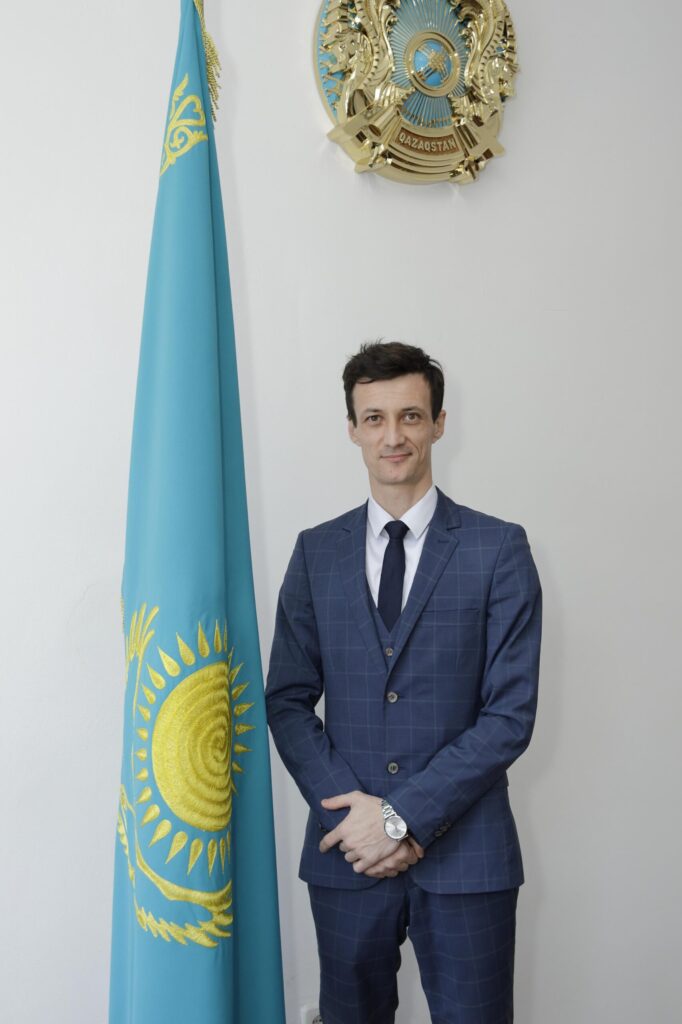
Chief technologist of the workshop
Кirpichenko V.V.
The workshop for the production and implementation of drugs was established in 2023 in accordance with the staffing table. Since January 2025, the workshop has been headed by the chief technologist, Candidate of Veterinary Sciences Кirpichenko V.V. The main activity of the workshop is the implementation into production and release of veterinary drugs developed by scientists of the Institute and approved for use in veterinary medicine. The workshop employs 13 highly qualified employees.
As a result of the scientific and production activities of the workshop in 2023, it was produced by state order and delivered to economic entities:
Hemolytic serum of animal blood for serological reactions, widely used in veterinary laboratories in the diagnosis of infectious diseases – 86,308,625.70 doses;
Roz-Bengal antigen for lamellar agglutination reaction (roz bengal test-RBP) in the diagnosis of brucellosis of animals – 15 liters;
Kit for serological diagnosis of epizootic lymphangitis of horses – 2333.90;
Color antigen for ring reaction (CR) with milk in the diagnosis of brucellosis of farm animals – 13.2;
Kit for the diagnosis of infectious epididymitis of sheep – 582,662,60 doses;
A single brucellosis antigen for the diagnosis of brucellosis – 223 doses;
The drug “Cestremforte” for the treatment and prevention of echinococcosis of carnivorous animals – 2,496,972 doses;
Live dry vaccine against salmonella abortion of mares from the strain “Salmonella abortus-equi E-841” – 22370 doses;
Liquid live vaccine against anthrax of animals from the strain “55- VNIIVViM” – 40,136,575 doses.
The above-mentioned veterinary medicines are widely used throughout the territory of the Republic of Kazakhstan.
In the future, the workshop plans the following scientific research:
– to test the diagnostic and preventive effectiveness of the Institute’s developments in production conditions with the further application of drugs into veterinary practice;
– maintaining the well-being of livestock farms for various infectious, non-communicable and parasitic diseases with the development of new and improvement of existing preventive, diagnostic and therapeutic biological products.
Management and Quality Assurance Department (MQAD)

Head of the Department
Serikov Maksat Serikovich
The Department of Management and Quality Assurance (DMQA) was established in 2023, as an independent structural unit of the Institute for strategic planning and direct implementation of quality diagnostics and documentation management for management system processes.
The main purpose of DMQA activities is:
– development and development of an effective quality management system for the main and auxiliary activities of KazSRVI LLP;
– organization and conduct of internal audits MS;
-control and monitoring, updating of periodic changes in special types of normative and technical documents related to scientific and laboratory activities with the State Standards Fund of the Republic of Kazakhstan, national and international legislation;
– control, monitoring, updating of the Register of licenses, permits, certificates and certificates of the Institute.
DMQA’s personnel annually undergo qualification training in the field of technical regulation (internal and external).
The Department of Management and Quality Assurance (DMQA) was established in 2023, as an independent structural unit of the Institute for strategic planning and direct implementation of quality diagnostics and documentation management for management system processes.
The main purpose of DMQA activities is:
– development and development of an effective quality management system for the main and auxiliary activities of KazSRVI LLP;
– organization and conduct of internal audits MS;
– control and monitoring, updating of periodic changes in special types of normative and technical documents related to scientific and laboratory activities with the State Standards Fund of the Republic of Kazakhstan, national and international legislation;
– control, monitoring, updating of the Register of licenses, permits, certificates and certificates of the Institute.
DMQA’s personnel annually undergo qualification training in the field of technical regulation (internal and external).
Currently, the Institute has implemented, documented and operates the following management systems in accordance with the requirements:
The State system of technical regulation of the Republic of Kazakhstan (accreditation):
– GOST ISO/IEC 17025-2019 (Test Center);
– GOST ISO/IEC 17043-2013 (Qualification Verification Provider);
The State System of Technical Regulation of the Republic of Kazakhstan (certification of integrated management systems):
– ST RK ISO 9001-2016 (ISO 9001:2015) “Quality management systems”;
– ST RK ISO 14001-2016 (ISO 14001:2015) “Environmental management systems”;
– ST RK ISO 45001-2019 (ISO 45001:2018) “Occupational safety and health management systems”;
– GOST R 52249-2009 (GMP EC) “Quality management systems for medicines and medical devicesIn accordance with the objectives set for 2024, DMQA is preparing to implement the rules of Good Manufacturing Practice (GMP) of the Eurasian Economic Union (EAEU) for the production activities of the Institute.
Scientists of the Institute carry out fundamental, applied scientific research and provides scientific advisory and practical assistance to economic entities of the Republic of Kazakhstan in the field of veterinary welfare.


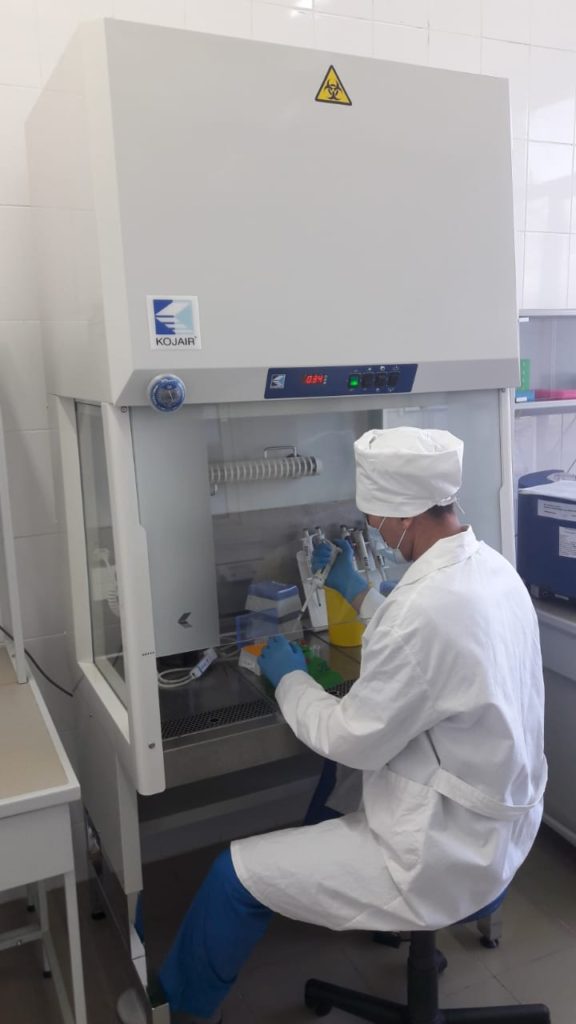



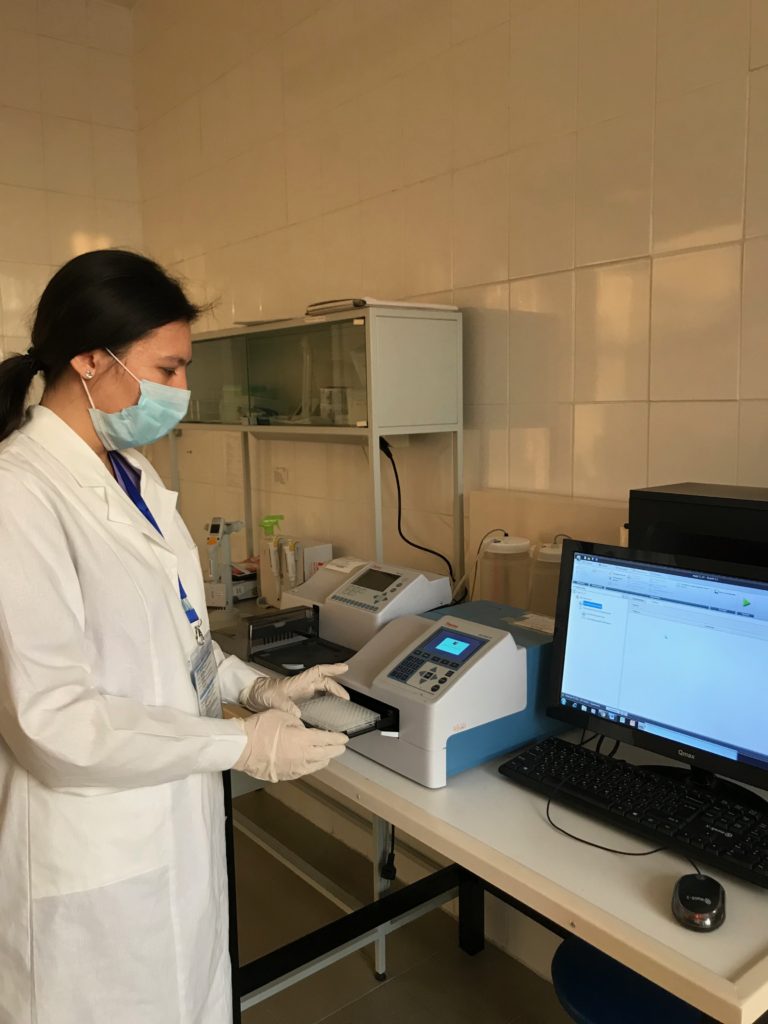
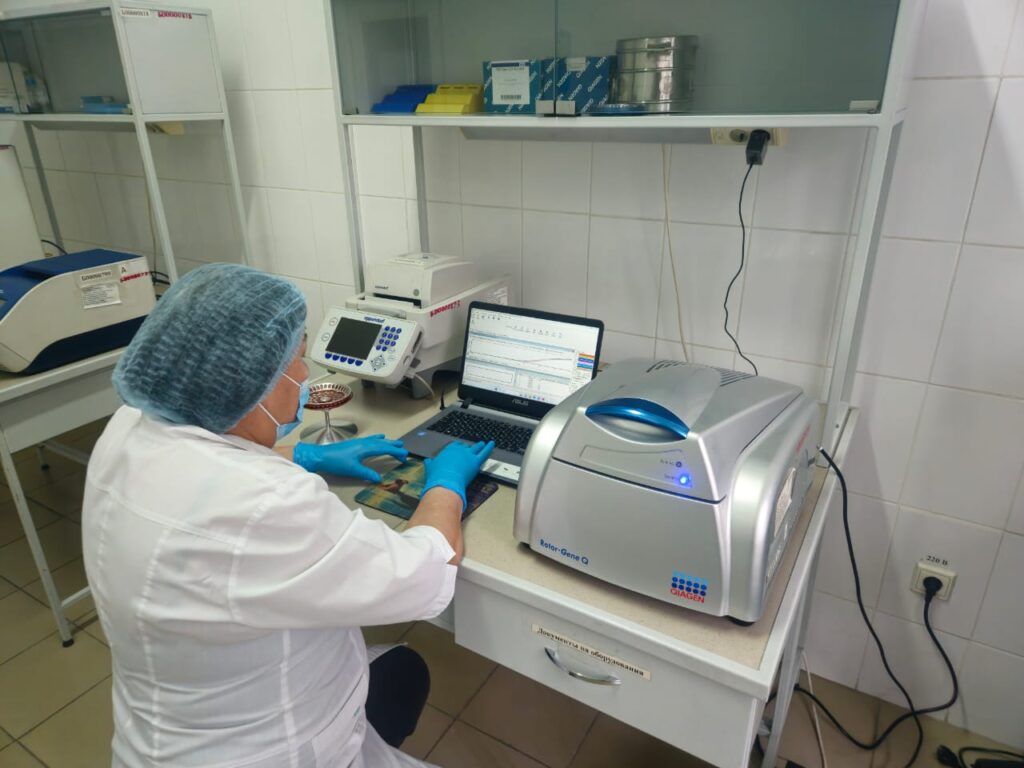
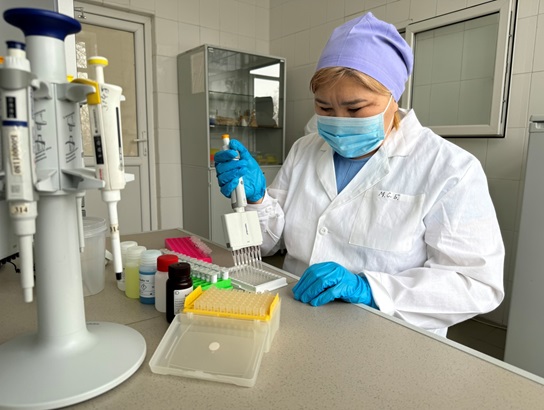
An important part of the work of KazSRVI LLP is the training of young scientists, holding seminars, meetings and international scientific and practical conferences on topical issues of veterinary medicine, lecturing for students of agricultural universities and conducting practical classes at advanced training courses for veterinary specialists, visits to livestock farms in order to conduct an epizootological examination and provide practical assistance in solving veterinary problems as well as conducting diagnostic studies.

Scientific and practical seminar of young scientists of the Kazakh SRVI


